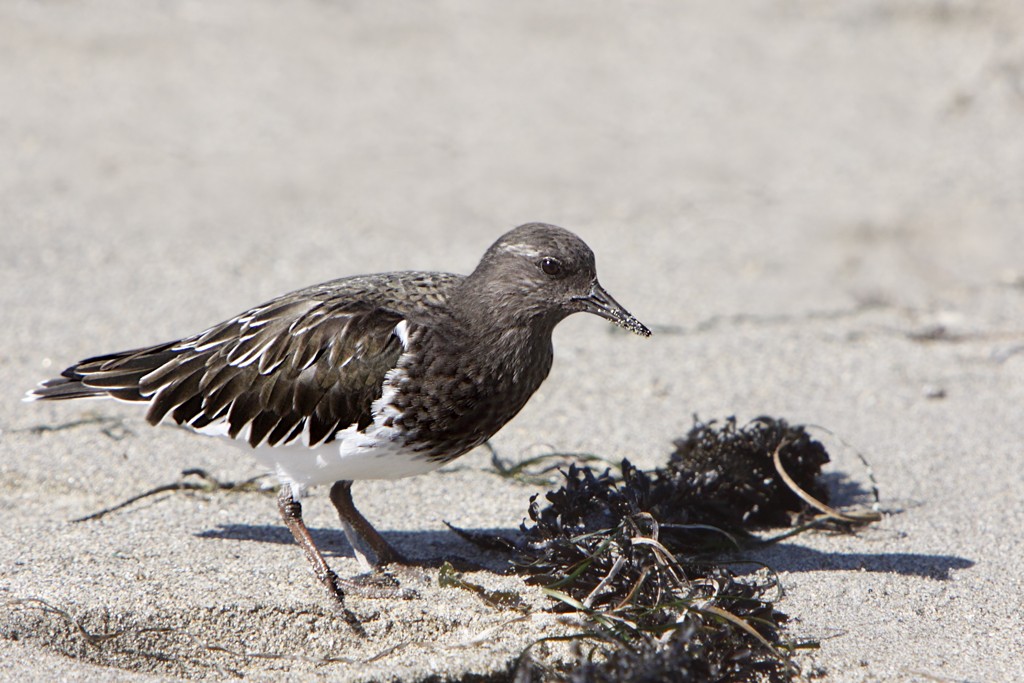Black Turnstone
A species of Turnstones Scientific name : Arenaria melanocephala Genus : Turnstones
Black Turnstone, A species of Turnstones
Botanical name: Arenaria melanocephala
Genus: Turnstones
Content
Description General Info
Description
It is 22–25 centimeters long and weighs 100–170 grams. The black bill is 20–27 millimeters long and slightly upturned. The legs and feet are blackish-brown with a reddish tinge. The bird is largely black and white in appearance. Breeding-plumaged adults have a black head and breast apart from a white spot between the eye and bill, a white stripe over the eye and white flecks on the sides of the breast. The upperparts are blackish-brown with pale fringes to the wing-coverts and scapular feathers. The belly and vent are white. In flight it shows a white wingbar, white shoulder patch and white tail with a broad black band across it. There is white from the lower back to the uppertail-coverts apart from a dark bar across the rump. In winter the head and breast become largely dark brown with little white. Juveniles are similar to winter adults but browner with buff fringes to the wing-coverts and scapulars and a grey-brown tip to the tail. The ruddy turnstone is similar but has rufous-brown markings on the upperparts and more white on the head and breast, particularly in breeding plumage. It has narrower wings and a narrower white wingbar. Its legs are orange and brighter than those of the black turnstone though there can be some overlap. The black turnstone has a variety of calls, especially a rattling trill which can be heard throughout the year. This call is higher and less harsh than the similar call of the ruddy turnstone. Other calls include a loud, screeching alarm call and a soft, purring call uttered to young chicks. Displaying males produce a long series of staccato notes in flight as well as chirruping trills on the ground. 
Size
23 cm (9 in)
Life Expectancy
4.8-9 years
Nest Placement
Ground
Feeding Habits
Black Turnstone forage by flipping over beach debris with their bills and snowplowing into seaweed to find prey like insects, crustaceans, fish eggs, and worms. They pry open hard-shelled invertebrates and consume berries, seeds, and carrion during their breeding season.
Habitat
Black Turnstone thrive in rocky coastal habitats along Pacific shorelines, where high surf creates ideal conditions. They forage and roost among rocks and boulders, often utilizing man-made structures such as jetties. Breeding grounds include arctic coastal lowlands with sedge and beach rye, and some nest in elevated areas with willows and moss. Post-breeding habitats extend to gravel-lined shores and coastal mudflats with scattered stones.
Nest Behavior
During nesting, both sexes of black Turnstone collaborate to line their scrapes with local vegetation. Precise timings for nest construction and egg-laying are not detailed here; parental roles in incubation and care for the young after hatching remain to be specified.
Nest Characteristics
Black Turnstone construct their nests as bowl-shaped scrapes amongst sedges, typically on small islands in brackish ponds or river islands, often under willows. Their nests, camouflaged with overhanging vegetation, are lined with nearby plant materials and measure approximately 3.9 inches wide by 1.7 inches deep.
Dite type
Aquatic invertebrate eater
General Info
Feeding Habits
Bird food type
Behavior
The black Turnstone exhibits a captivating array of behaviors, particularly during breeding season. Males ardently claim territories, engaging in mid-air chases and performing intricate displays that involve flying in circles at notable heights, accompanied by unique vocalizations. These displays, which may persist for several minutes, are a prelude to courtship, culminating in coordinated flights with potential mates. The black Turnstone engages in ground displays too, where couples communicate through an elaborate language of tail raising, wing hoisting, and pseudo-nest building. These birds, which demonstrate monogamy, share parental responsibilities seamlessly, often rekindling partnerships over successive seasons.
Distribution Area
It breeds in western Alaska from the Alaska Peninsula in the south to Point Hope in the north. The bulk of the population nests in the Yukon-Kuskokwim Delta. It usually nests near the coast but in some areas it occurs further inland along the shores of rivers and lakes. There are a handful of records from north-east Siberia but there has been no sign of breeding there. The world population is estimated at 95,000 birds with about 80,000 of these in the Yukon-Kuskokwim Delta. It winters on rocky shores along the Pacific coast of North America from southern Alaska southwards as far as north-west Mexico where it occurs in Baja California and Sonora with a single record from Nayarit. It is very occasionally seen inland during spring and fall migration; there are a number of records from the Salton Sea in southern California and scattered sightings from inland US states including Montana, Wisconsin, Nevada and Arizona. Vagrant birds have been recorded from Yukon and the Northwest Territories and there is one record from San Cristóbal Island in the Galápagos Islands. 
Species Status
Not globally threatened.
Scientific Classification
Phylum
Chordates Class
Birds Order
Shorebirds Family
Sandpipers Genus
Turnstones Species
Black Turnstone 